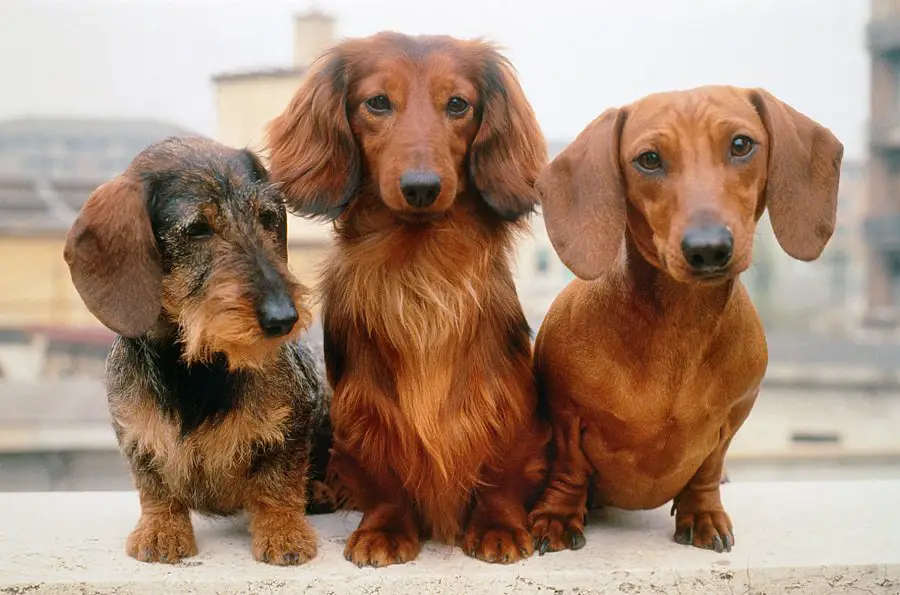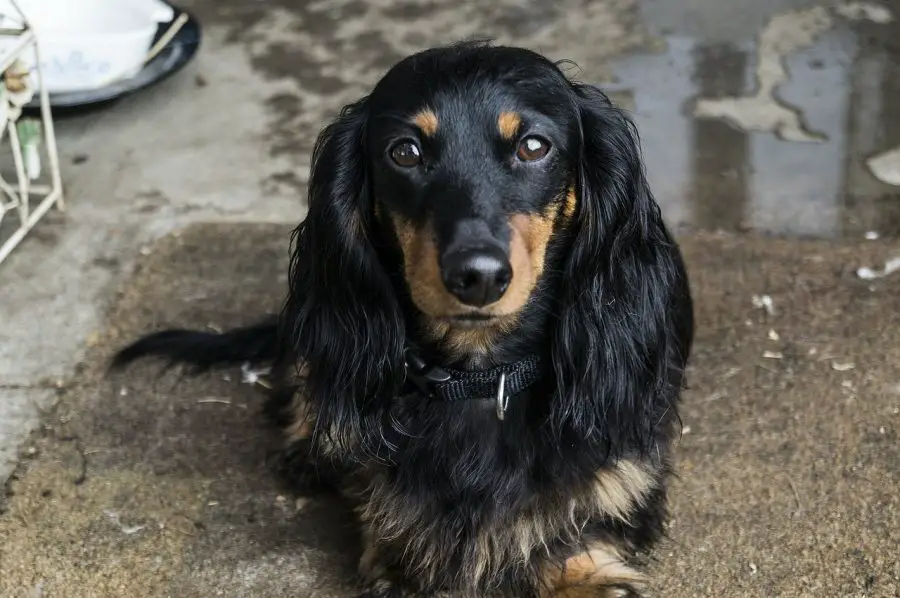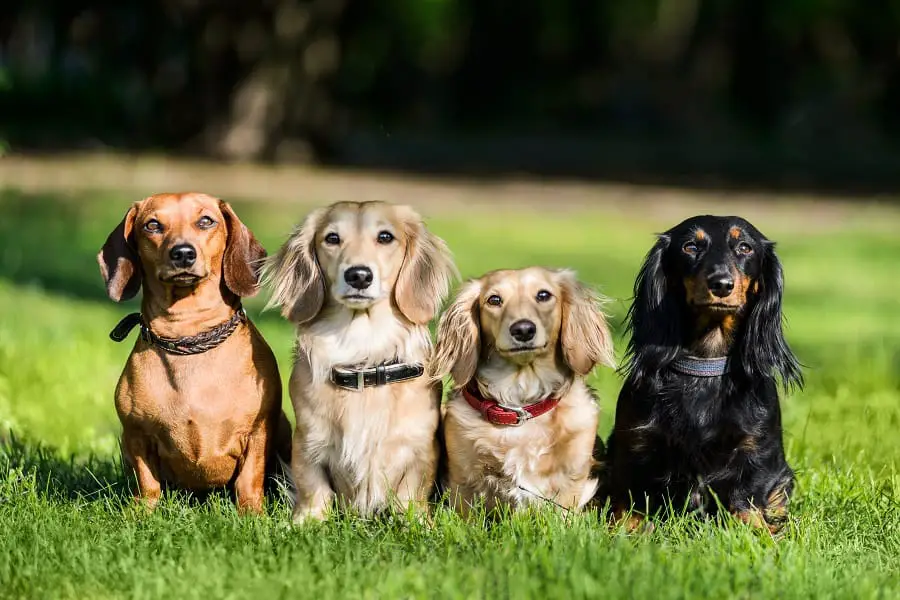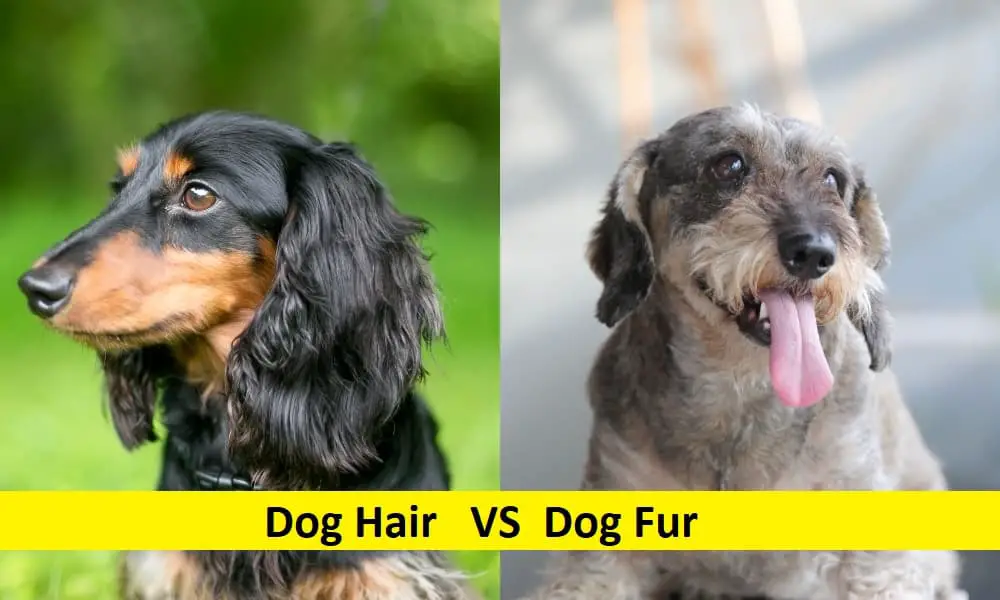Dachshunds come in different coats, the most common being the single coated dachshund. These dachshunds shed the least and are the most popular.
Their coats are short and shiny and don’t require grooming more than once a week. These are the original dachshunds that was bred in Germany sometime in the 1600s. These dogs’ coats can be classified as fur.
The long-haired dachshunds are quite lovely too. They were produced by crossbreeding smooth haired dachshunds with breeds like German Stoberhund.
It tends to be on the wavier side and they often have a double coat, with their undercoats being fluffy. This makes them ideal for colder weather climates.
They tend to shed more and require grooming once a day with a bristle brush. The hair can also become tangled and might need untangling once in a while. Their outer-coats are classified as hair.
Wire haired dachshunds also have a double coat with thick undercoats and bushy and bristly outercoats.
They are dachshunds that were crossbred originally with other species like Dandie Dinmont Terrier and Schanuzer in the late 19th century.
The unruly character of their hair means that these little doxies require quite a bit of grooming effort on a daily basis to remove tangles.

These dogs also require stripping and plucking at least once a year, a process involving pulling out dead hairs from the outer-coat, allowing new and healthy hair to grow naturally. Wire-haired terriers have fur.
Sometimes the type of coat also dictates the colors of the breed. Doxies usually come in a reddish-brown color or a cream color. Some dachshunds are also black and tan or brown and tan.
In other words, dachshunds can have either hair or fur, depending on their breed.
Why Does it Matter Whether Your Doxie Has Hair or Fur?
Differing Grooming Techniques
As we have already seen, one of the primary reasons for understanding whether your doxie has hair or fur is to better understand its grooming requirements.
Smooth coated dachshunds have very different requirements from longhaired dachshunds, whose grooming needs are again very different from wirehaired dachshunds.
All of them don’t required the same amount of grooming, nor the same type. While it is fine to groom the smooth coated dachshunds just once a week, it becomes important to groom the other varieties far more often.
Dealing with Allergies
Some dachshunds are hypoallergenic. However, it’s a common misconception that it’s the shedding of dog hair or fur leads to allergies.
This is not true as the fur or hair itself don’t act as allergens. Allergies are actually caused by dander and other compounds in the saliva and skin of dachshunds. In some breeds, these allergens can be trapped in their coats.
This is most likely to happen with the long-haired dogs whose fur gets trapped in the coats.
However, dachshunds in general, are not as hypoallergenic as most other breeds since they don’t produce as much dander because of their small size.
It’s actually quite a safe dog for people with allergies, irrespective of the coat type.
I would still avoid the wire-haired dachshunds if you have allergies because their wiry fur can trap dander if they aren’t groomed properly.
All Breeds Have their Own Personalities
All breeds of dogs have some typical personality traits depending on their history and the purpose for which they were bred.
This is why we see that terriers are brave and determined while spaniels are quiet and affectionate. Dachshunds too have their own personality type. They are stubborn, brave, independent, and playful.
Smooth-coated dachshunds show most of these personality traits to a T.

But since both wirehaired and longhaired dachshunds are crossbreeds, they can show personality traits of the breeds that are part of their lineage.
For example, wire-haired dachshunds more or less show personality traits of terriers. Hence, they can be mischievous and very lively.
Long-haired dachshunds are considered to be the “aristocratic” dachshunds with gentle, charming, and quiet personalities.
Growth Cycle
As already mentioned above, whether your doxie has hair or fur can be discovered by keeping an eye on the growth cycle. Dachshunds have four growth phases for their hair / fur.
The first phase is the anagen phase, during which the follicle becomes active. Dogs with hair go through a much longer anagen phase than dogs with fur.
Then comes the catagen phase, during which the growth stops, and the roots of the hair are strengthened. Then comes the telogen phase, during which the dog is as she or he should be.
Final phase is the exogen phase, when the dog begins to shed. This phase lasts longer for dogs with fur, and they shed a lot. Then the cycle begins all over again.
This hair growth cycle means that it becomes imperative to understand when your dachshund will begin shedding and knowing whether he or she has hair or fur makes it much easier to handle this phase.
Types of Dog Coats

Different breeds of dogs have different types of coats. These determine their habits and their grooming requirements.
Since there are hundreds of breeds of dogs, there are also a large variety of different types of coats.
Some dogs have hair and others have fur; some are single coated while others have double coats. Some of the most common types of coats dogs have are:
Smooth coated: These include short coated breeds whose fur is very short and lays quite close to the body. These dogs don’t shed a lot and are quite easy to groom.
Double coated: Dogs with double coated fur tend to be quite tough since the inner coat provides them with insulation and helps them to deal with bad weather easily while the outer coat keeps them clean.
However, such dogs shed a lot and require a lot of grooming.
Wire coated: Some dog breeds have wiry coats and are a nightmare to groom. The fur on these dogs are tough and stiff and doesn’t easily lend itself to brushing. You might have to resort to hand stripping.
Curly coated: Like with human hair, curly coats need to be brushed regularly to keep the tangles out. It’s also a good idea to keep them trimmed.
Long haired: Some dogs have long, fine hair that has to be groomed regularly in order to keep them from shedding all over the place. But it’s also an easier option to groom.
Hairless: And then, there are the hairless dogs, who don’t have much hair or fur and are a godsend to pet owners with allergies. However, these dog breeds are less hardy and more exposed to the elements.
Difference between Hair and Fur

With so many different types of coats, it begs the question: what is the difference between hair and fur in dogs? On the surface, it appears as if they are both the same and indeed, these terms are often used interchangeably.
But there are minor differences between the two, which can affect the behavioral patterns and grooming requirements of a pet dog.
Both fur and hair are made up of keratins (protein compounds). But there are differences between the two, which might turn out to be important for caring for your little one.
A major difference between the two is that fur tends to stop growing at a certain length and hair keeps growing indefinitely. Fur is short and coarse, while hair is softer.
You might be able to find out whether your dachshund has hair or fur by keeping an eye on the growth cycle – hair definitely has a longer cycle and sheds lesser than fur.
Another point to note is that fur is short and coarse to the touch while hair feels silkier and smoother.
The differences can be very subtle at times. But scientifically, it all boils down to one thing. When a single hair grows from a single hair follicle on the dachshund’s coat, it is classified as hair.
Dogs with fur have compound hair follicles, that is, multiple strands of hair grow from a single follicle.
This might not matter much but it is useful to understand and know this because it sometimes has impact on a doxie’s health.
In general, dogs with fur tend to have double coats, but with dachshunds, it is wiry haired dachshunds who often tend to have double coats.
Of course, it is very possible for mixed breeds to have double coats as well. Smooth coated dachshunds have only a single coat of short fur.
Conclusion
In conclusion, your dachshund might have either hair or fur, depending on its breed. You can have it checked out by an expert or just check it yourself now that you know how to do so.
It is important that the knowledge about the fine distinctions between hair and fur in your little dog is incorporated into their daily care and hygiene.
